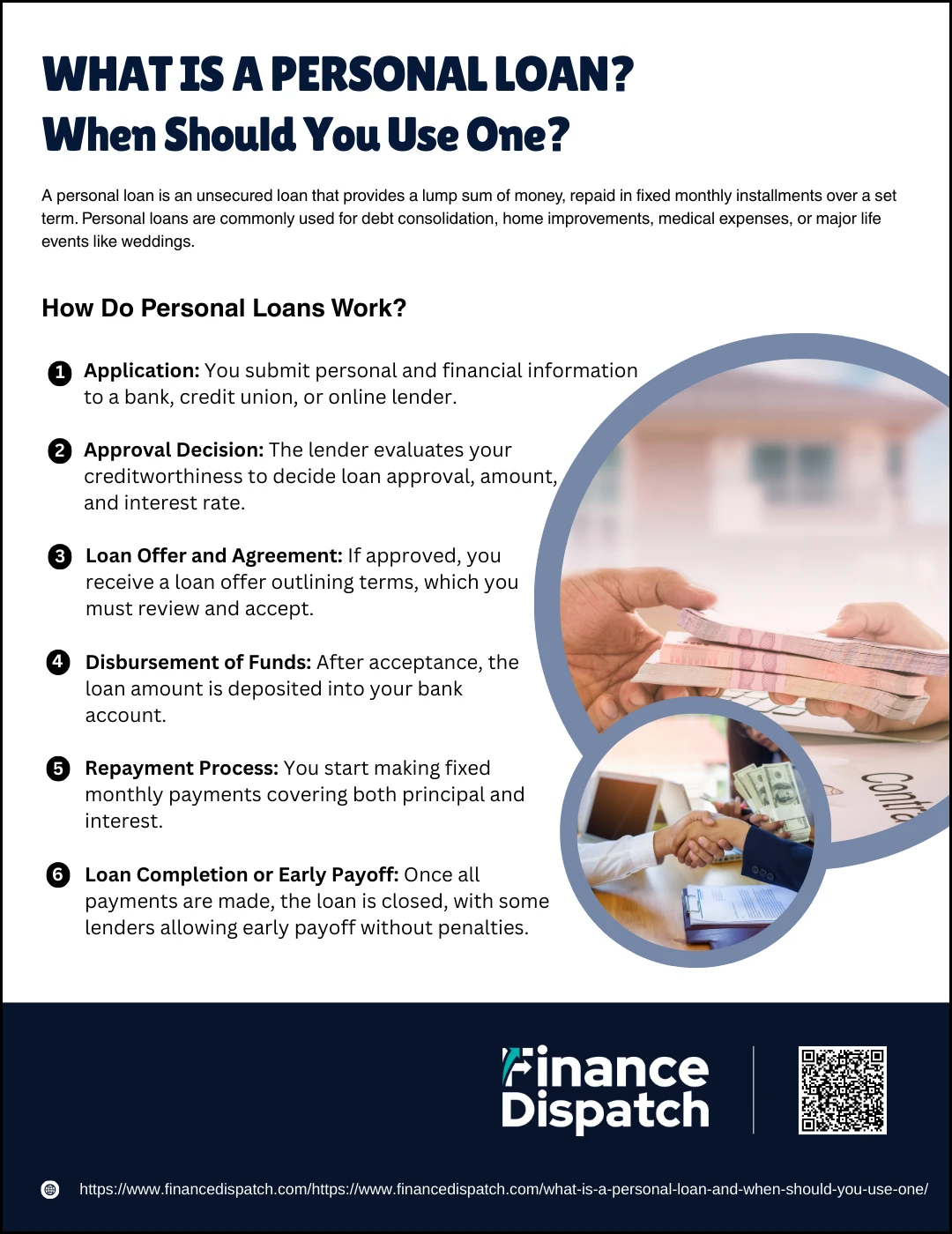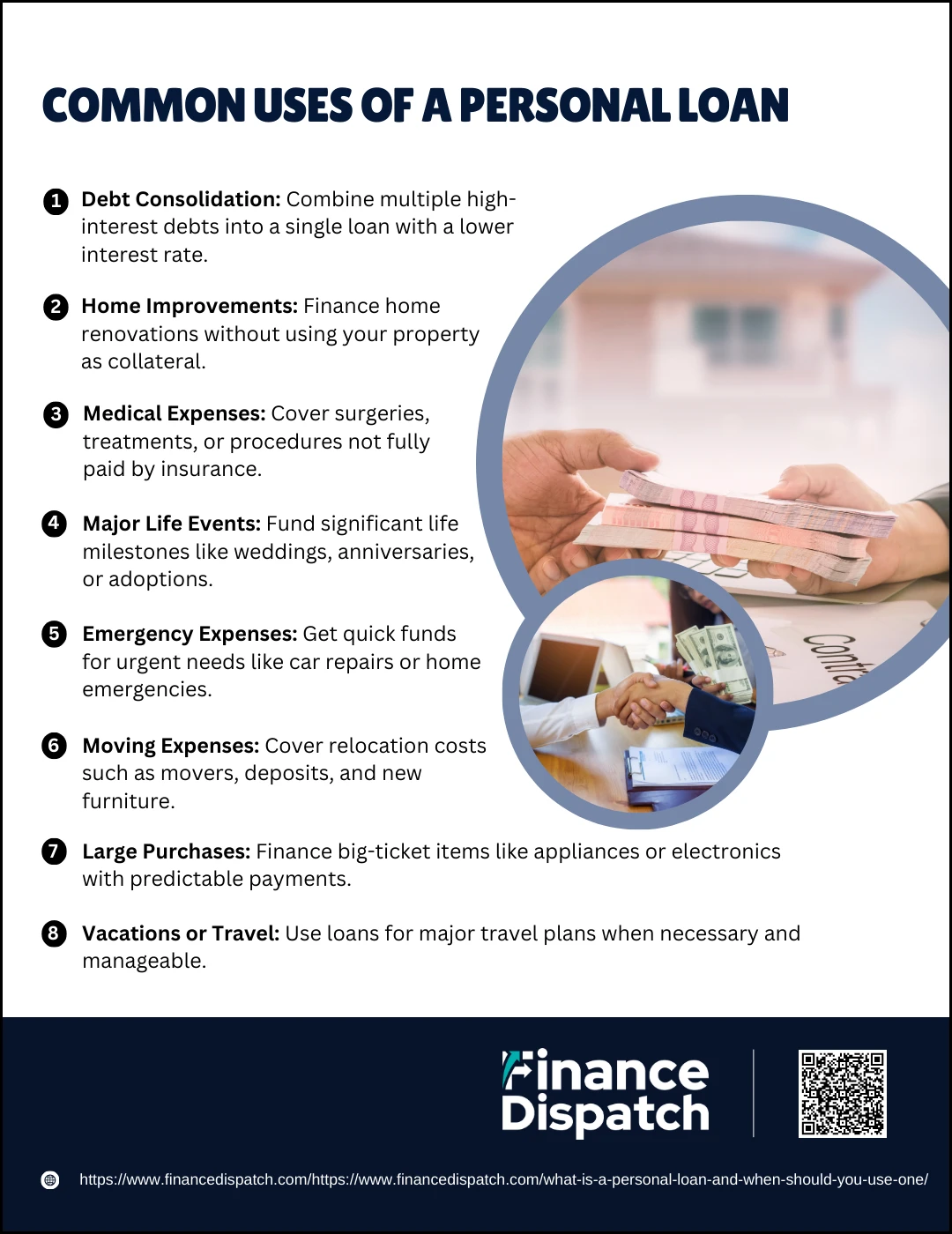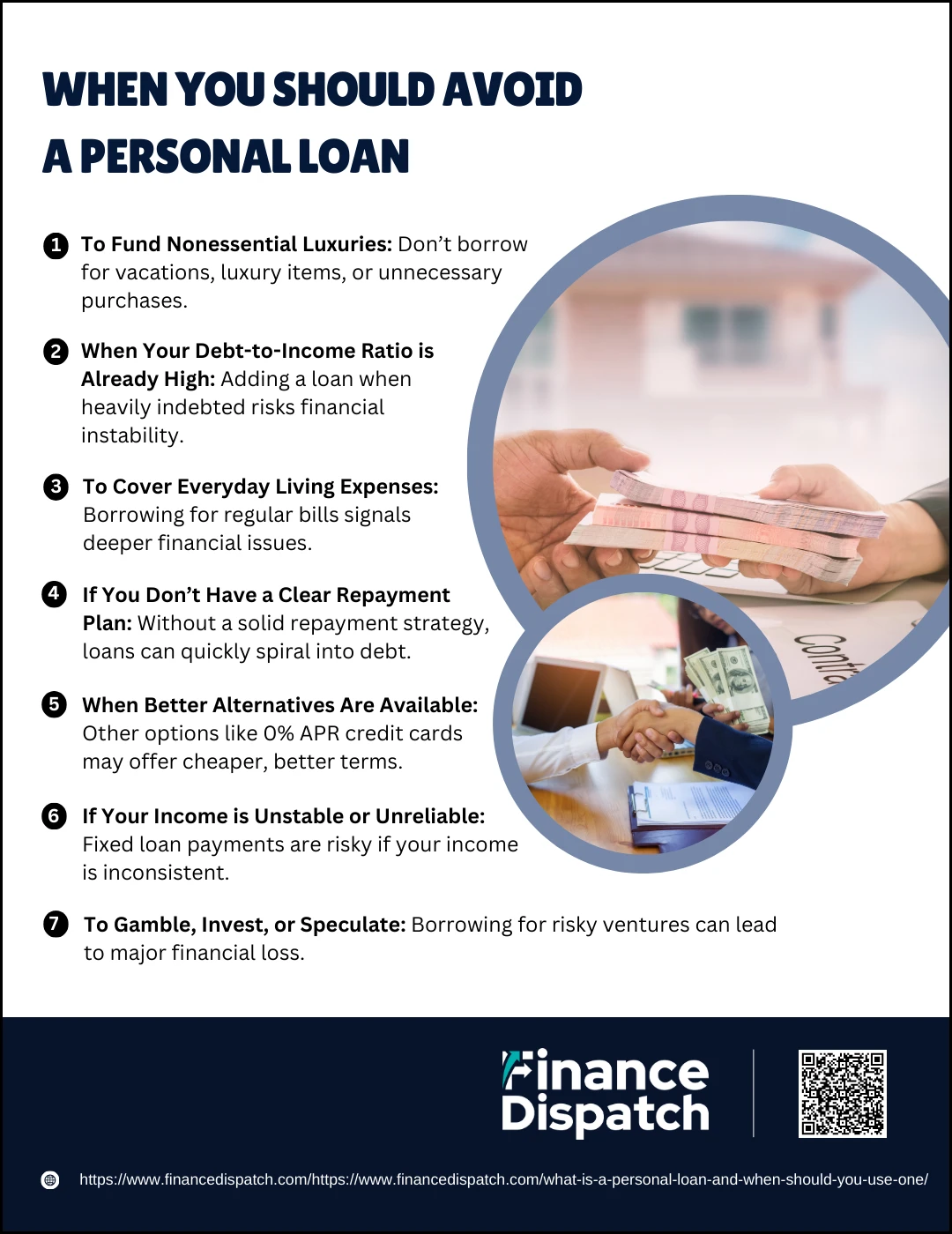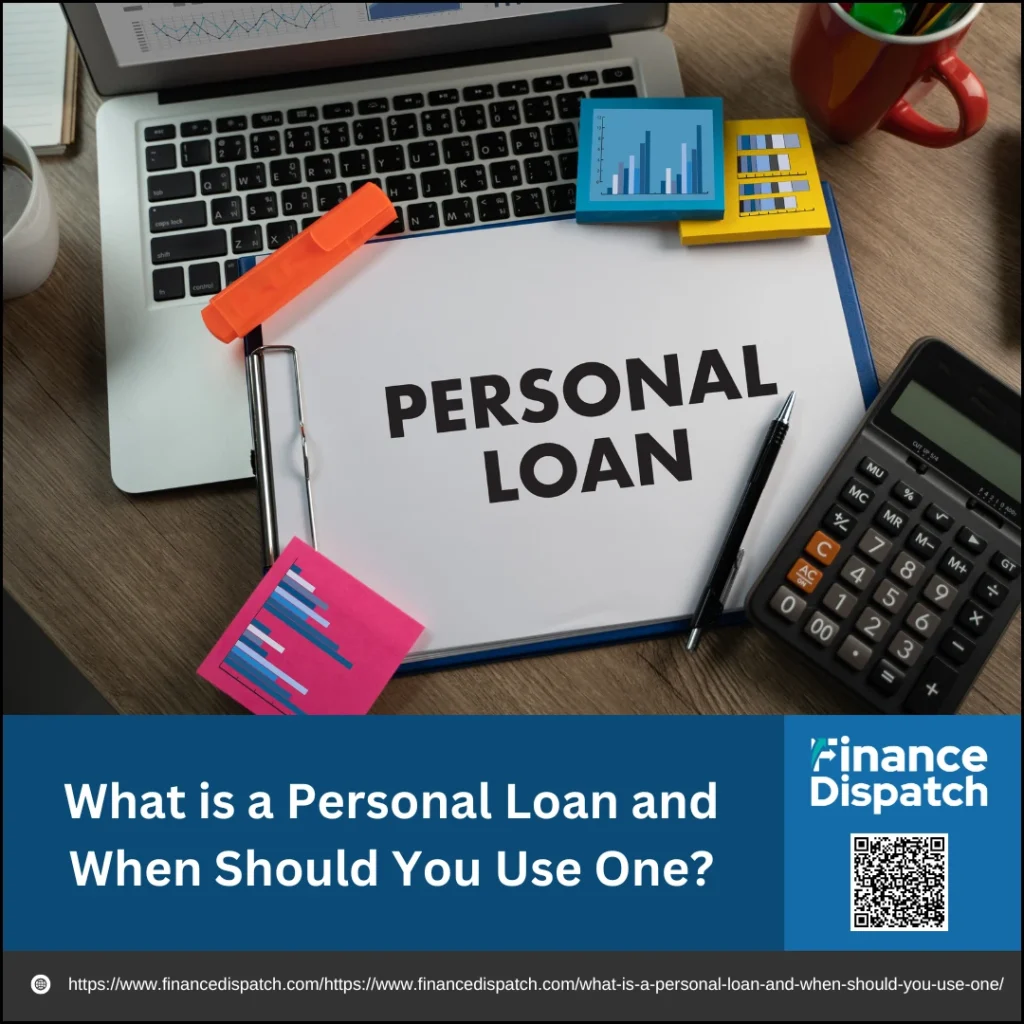When you’re faced with a large expense or looking to consolidate high-interest debt, a personal loan can be a powerful financial tool. Offering flexible use, fixed repayment terms, and typically lower interest rates than credit cards, personal loans are designed to help you manage significant costs without tying up your assets as collateral. However, like any borrowing option, they are not suited for every situation. In this article, we’ll explore what a personal loan is, how it works, and most importantly, when it makes sense to use one to your advantage.
What is a Personal Loan?
A personal loan is a type of installment loan that provides you with a lump sum of money, which you repay over a fixed period through regular monthly payments. Unlike mortgages or auto loans that are used for specific purposes, personal loans are often unsecured and can be used for a wide range of expenses—from consolidating credit card debt to covering emergency medical bills or financing home improvements. Because they are usually unsecured, lenders base approval on factors like your credit score, income, and debt-to-income ratio, rather than requiring collateral such as a house or car. Personal loans also typically offer fixed interest rates and predictable repayment terms, making them a popular choice for borrowers seeking flexibility and financial stability.
 How Do Personal Loans Work?
How Do Personal Loans Work?
A personal loan is a form of financing where you borrow a lump sum of money and repay it over a set period with fixed monthly payments. These loans are often unsecured, meaning you don’t need to offer any collateral like a home or car. Personal loans can be used for a wide range of purposes, such as consolidating high-interest debts, funding major purchases, or covering unexpected expenses. Understanding each step of how personal loans work—from application to final repayment—can help you manage the borrowing process wisely and avoid surprises along the way.
Here’s a step-by-step look at how personal loans typically work:
1. Application
You start by applying through a bank, credit union, or online lender. During the application, you’ll submit personal and financial information, including your income, employment status, and possibly your reason for borrowing.
2. Approval Decision
The lender reviews your credit score, debt-to-income ratio, and income details to assess your ability to repay. Based on this review, they determine whether you qualify for the loan and what interest rate and loan amount to offer.
3. Loan Offer and Agreement
If approved, you’ll receive a loan offer outlining key details like the loan amount, annual percentage rate (APR), monthly payment amount, repayment term, and any applicable fees. You must carefully review and accept the offer by signing the loan agreement.
4. Disbursement of Funds
Once you accept the offer, the lender deposits the approved funds directly into your bank account. This can happen as quickly as the same day or may take a few business days, depending on the lender.
5. Repayment Process
Repayment usually begins within 30 days of receiving the funds. You’ll make fixed monthly payments that cover both principal and interest, continuing until the loan is paid off. Fixed payments mean your monthly amount stays the same throughout the loan term.
6. Loan Completion or Early Payoff
When all scheduled payments are made, your loan is considered fully paid off. Some lenders also allow early repayment without penalties, helping you save on interest costs if you can pay off the balance sooner.
 Common Uses of a Personal Loan
Common Uses of a Personal Loan
A personal loan offers incredible flexibility, making it one of the most versatile financial tools available today. Unlike auto loans or mortgages, which must be used for specific purchases, personal loans can be applied toward a wide range of needs. Whether you are dealing with an unexpected emergency, planning a major life event, or simply trying to manage your finances better, a personal loan can help you cover costs with predictable repayment terms. Understanding the common uses of personal loans can help you determine whether borrowing is the right solution for your situation.
Here are some of the most common ways people use personal loans:
1. Debt Consolidation
Many people take out a personal loan to consolidate multiple debts—especially high-interest credit card balances—into one single loan with a lower, fixed interest rate. This makes monthly payments easier to manage and can save a significant amount of money on interest over time.
2. Home Improvements
Personal loans are often used to pay for home renovation projects, such as kitchen remodels, roof repairs, or new flooring. Since they don’t require you to put your home up as collateral (like a home equity loan would), personal loans offer a faster and less risky way to finance necessary improvements.
3. Medical Expenses
Health-related costs can be overwhelming, particularly if your insurance doesn’t cover everything. A personal loan can help pay for surgeries, emergency treatments, dental procedures, fertility treatments, or other medical needs without delay, allowing you to focus on recovery instead of financial stress.
4. Major Life Events
Weddings, milestone birthdays, anniversaries, or even adoption expenses can add up quickly. Rather than using high-interest credit cards, a personal loan can spread these costs over time, making it easier to celebrate important moments without sacrificing financial stability.
5. Emergency Expenses
Life can be unpredictable. A sudden car breakdown, urgent home repairs, or family emergencies often require immediate funds. Personal loans provide quick access to money, helping you manage unexpected situations without tapping into savings or retirement accounts.
6. Moving Expenses
Relocating to a new home, especially over long distances, can be expensive. A personal loan can cover moving company fees, transportation costs, deposits, and even the purchase of essential furniture, helping you start fresh without financial strain.
7. Large Purchases
Sometimes you may need to replace a major appliance, invest in new electronics, or furnish a home. A personal loan allows you to make necessary large purchases right away and repay the cost in fixed monthly installments.
8. Vacations or Travel
While it’s generally better to save for vacations, there are times—such as a once-in-a-lifetime family trip or a destination wedding—when using a personal loan could make sense. Just be cautious and ensure the repayment fits comfortably within your budget.
 When Should You Use One?
When Should You Use One?
Personal loans can be a valuable financial tool when used carefully and strategically. They offer flexible funds, usually at lower interest rates than credit cards, and come with clear repayment terms. However, not every financial need requires taking on debt. You should consider using a personal loan only when it helps you achieve a clear financial goal, reduces your costs, or prevents you from falling into deeper financial trouble. Knowing the right time and reason to borrow can protect your credit, your savings, and your peace of mind.
Here are the most common situations where using a personal loan makes good financial sense:
1. Consolidating High-Interest Debt
When you have multiple debts with high interest rates—especially credit cards—a personal loan can help combine them into a single loan with a lower fixed rate. This not only simplifies your finances but can save you a significant amount in interest over time, helping you pay off your debt faster.
2. Covering an Unexpected Emergency Expense
Life can throw unexpected expenses your way, such as emergency medical bills, urgent car repairs, or necessary home repairs. A personal loan can provide fast access to funds, allowing you to handle the emergency without maxing out your credit cards or draining your emergency savings.
3. Financing Important Home Repairs or Improvements
If your home needs urgent upgrades—such as a leaking roof, broken heating system, or safety improvements—a personal loan can cover the costs quickly without using your property as collateral, as a home equity loan would require. It’s a good option when time and flexibility matter most.
4. Paying for a Major Life Event
Milestones like weddings, anniversaries, or family expansions often come with large expenses that may not be fully covered by savings. Using a personal loan allows you to spread the cost over several years with predictable payments, making these events more manageable financially.
5. Bridging a Short-Term Cash Flow Gap
If you’re expecting money soon—such as a year-end bonus, tax refund, or proceeds from a property sale—but need funds immediately for an important purchase or expense, a short-term personal loan can bridge the gap without the long-term commitments or high interest rates associated with credit cards.
6. Improving Your Credit Mix
Your credit score benefits from having a diverse mix of credit types. If your credit report shows only revolving debt (like credit cards), adding a responsibly managed installment loan—like a personal loan—can strengthen your credit profile and potentially boost your score over time.
When Should You Consider a Personal Loan?
A personal loan can be a smart choice when you need access to funds and want a structured repayment plan with predictable monthly payments. It’s especially helpful if you’re seeking a lower-cost alternative to credit cards or need financing for specific personal needs. However, it’s important to make sure that taking on new debt aligns with your financial goals and that you can comfortably afford the repayments. Considering a personal loan in the right circumstances can help you manage your money more efficiently and avoid costlier borrowing options.
Here are some situations where you might want to consider a personal loan:
1. You need to consolidate high-interest debt.
A personal loan with a lower interest rate can simplify your payments and help you pay off debt faster.
2. You don’t have enough savings for an urgent expense.
If an emergency arises and your savings are limited, a personal loan can provide quick access to the funds you need.
3. You want predictable monthly payments.
Personal loans usually come with fixed interest rates and fixed terms, so you know exactly how much you owe each month.
4. You don’t have collateral for a secured loan.
If you can’t or don’t want to risk assets like your home or car, an unsecured personal loan could be a safer option.
5. You’re financing a major purchase or home project.
Whether it’s a necessary appliance, medical treatment, or a critical home repair, a personal loan can help you cover big expenses without disrupting your budget.
6. You prefer a quicker, simpler borrowing process.
Compared to loans like home equity loans or lines of credit, personal loans often require less paperwork and can be approved and funded much faster.
7. You want to improve your credit profile.
Successfully managing a personal loan can strengthen your credit score by improving your credit mix and demonstrating consistent, on-time payments.
 When You Should Avoid a Personal Loan
When You Should Avoid a Personal Loan
Although personal loans offer flexibility and fast access to funds, they are not always the right financial solution. Taking out a loan without a clear repayment strategy or borrowing for the wrong reasons can lead to long-term financial strain and damage your credit health. It’s important to understand that personal loans are best used for essential needs and planned purposes, not for temporary conveniences or risky ventures. Knowing when to avoid taking on new debt can save you from unnecessary financial pressure and help you build a stronger, more secure future.
Here are key situations when you should avoid using a personal loan:
1. To Fund Nonessential Luxuries
Using borrowed money to finance vacations, luxury items, or extravagant lifestyle purchases can burden you with long-term debt for short-term enjoyment. If the expense is not urgent or necessary, it’s wiser to save up instead.
2. When Your Debt-to-Income Ratio is Already High
If a significant portion of your income already goes toward debt payments, adding another loan can stretch your budget too thin. A high debt-to-income ratio can also make it harder to qualify for future loans or favorable interest rates.
3. To Cover Everyday Living Expenses
Relying on personal loans to pay for groceries, rent, utilities, or other regular bills is a red flag that your budget needs restructuring. Borrowing for daily expenses can quickly lead to a cycle of debt that is difficult to escape.
4. If You Don’t Have a Clear Repayment Plan
Before taking a loan, you should have a realistic strategy for repaying it within the agreed term. Borrowing without a solid plan could result in late payments, higher interest charges, and serious damage to your credit score.
5. When Better Alternatives Are Available
In some cases, other financial options—such as 0% introductory APR credit card offers, borrowing from a savings account, or a home equity loan—may offer lower costs or better flexibility. Always compare alternatives before committing to a personal loan.
6. If Your Income is Unstable or Unreliable
A personal loan requires regular, consistent payments. If your job situation is unstable, or your income fluctuates significantly (such as seasonal work or freelancing), taking on a fixed loan payment could create serious financial stress.
7. To Gamble, Invest, or Speculate
Using borrowed money to fund gambling, speculative investments, or other high-risk ventures can be extremely dangerous. If the gamble doesn’t pay off, you’re left with a loan balance to repay—and no gains to show for it.
Pros and Cons of Personal Loans
Like any financial product, personal loans come with both advantages and disadvantages. While they can offer quick access to cash, lower interest rates compared to credit cards, and predictable monthly payments, they are not the right solution for every financial need. It’s important to weigh the benefits against the potential drawbacks before deciding if a personal loan is the best choice for your situation. Understanding the full picture can help you make a smarter, more informed borrowing decision.
Here’s a simple breakdown of the pros and cons of personal loans:
| Pros | Cons |
| Lower Interest Rates compared to credit cards, especially for borrowers with good credit. | Origination Fees and Other Charges can increase the total cost of borrowing. |
| Fixed Monthly Payments make budgeting easier and offer repayment predictability. | High Rates for Poor Credit borrowers, sometimes comparable to or worse than credit cards. |
| No Collateral Required for unsecured loans, reducing the risk of losing personal assets. | Risk of Overborrowing if you take out a larger loan than necessary. |
| Quick Access to Funds, often within a few days, ideal for urgent financial needs. | Potential Credit Damage if you miss payments or take on more debt than you can handle. |
| Flexible Use of Funds for various personal expenses, from debt consolidation to emergencies. | Limited Flexibility After Approval — fixed payment schedules might be tough during financial hardship. |
How to Qualify for a Personal Loan
Qualifying for a personal loan depends on several key factors, including your creditworthiness, income stability, and overall financial profile. Lenders want to be confident that you can repay the loan on time and in full. Preparing in advance—by understanding what lenders look for—can greatly improve your chances of approval and help you secure better terms, such as a lower interest rate and fewer fees. Here’s what you should focus on before applying for a personal loan:
1. Check and Improve Your Credit Score
A higher credit score increases your chances of approval and helps you qualify for lower interest rates. Aim for a score of at least 670 or higher, but many lenders prefer scores above 700.
2. Demonstrate Stable Income
Lenders want proof that you have a reliable source of income to repay the loan. Be ready to provide pay stubs, bank statements, or tax returns during the application process.
3. Maintain a Low Debt-to-Income Ratio
Your debt-to-income (DTI) ratio compares your monthly debt payments to your gross income. A DTI below 36% is considered ideal by many lenders, showing that you can manage new debt responsibly.
4. Have a Clear Purpose for the Loan
Knowing exactly why you need the loan—and how much you need—helps you appear more credible to lenders and ensures you don’t borrow more than necessary.
5. Offer Collateral if Needed
If your credit profile is weaker, offering collateral (like a savings account or vehicle) can improve your chances of qualifying, although it converts the loan into a secured one.
7. Consider Using a Co-Signer
A co-signer with strong credit can help you get approved or qualify for a better rate. Just remember that your co-signer becomes equally responsible for repaying the loan.
8. Limit Other Recent Loan Applications
Too many recent loan or credit applications can hurt your credit score and make lenders wary. Apply only when you’re confident about your readiness and eligibility.
Alternatives to Personal Loans
While personal loans can be a convenient way to borrow money, they aren’t the only option available. Depending on your needs, financial situation, and credit profile, you might find other forms of financing that offer lower costs, greater flexibility, or fewer risks. Exploring different alternatives can help you find the best borrowing solution while avoiding unnecessary debt or higher interest rates.
Here are some common alternatives to personal loans:
1. Credit Cards with 0% Introductory APR Offers
Some credit cards offer promotional periods with 0% interest, which can be useful for short-term borrowing—especially if you can repay the balance before the promotional period ends.
2. Home Equity Loans or Home Equity Lines of Credit (HELOCs)
If you own a home with available equity, you may qualify for a home equity loan or HELOC at a lower interest rate than a personal loan. However, keep in mind that your home serves as collateral.
3. Personal Lines of Credit
A personal line of credit offers flexible borrowing, similar to a credit card, but often with lower interest rates. You can borrow only what you need and pay interest only on the amount used.
4. Borrowing from Savings or Emergency Funds
If you have savings available, using your own money can help you avoid debt altogether and save money on interest charges.
5. Borrowing from Retirement Accounts
Some 401(k) plans allow participants to borrow from their retirement savings. While this should be a last resort, it can provide access to funds without a credit check.
6. Family and Friends Loans
Borrowing from people you trust can offer flexible repayment terms and lower or no interest. However, it’s important to set clear agreements to avoid damaging relationships.
7. Peer-to-Peer (P2P) Lending Platforms
Online P2P platforms connect borrowers directly with individual lenders, often offering competitive rates based on your creditworthiness.
8. Credit Union Loans
Many credit unions offer small personal loans with lower fees and better interest rates compared to traditional banks, making them a great alternative for qualified members.
Conclusion
A personal loan can be a powerful financial tool when used thoughtfully for the right reasons. Whether you’re consolidating debt, covering unexpected expenses, or financing a major life event, it offers flexibility, predictable payments, and fast access to funds. However, it’s important to evaluate your financial situation carefully, compare alternatives, and borrow only what you can afford to repay. By understanding how personal loans work and when to use—or avoid—them, you can make informed decisions that support your financial stability and future goals.



